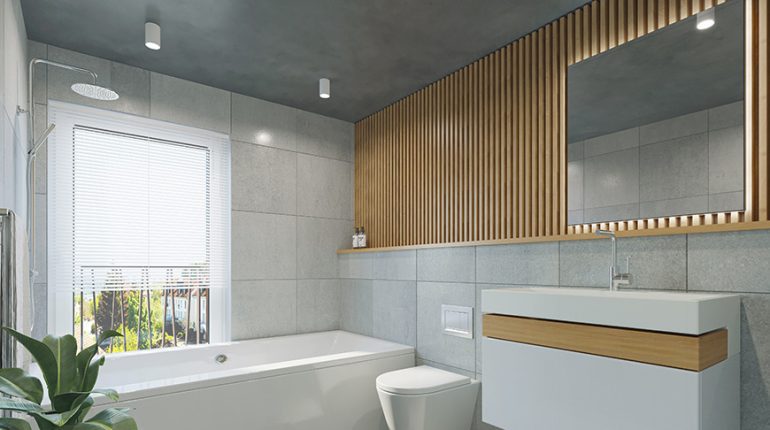
- Marvin
- /
Updated for 2025: This guide has been refreshed to include the latest bathroom paint innovations, moisture-resistant finishes, and expert tips to help you choose the best paint for your space.
A fresh coat of paint is one of the simplest and most cost-effective ways to revamp your bathroom. Whether you’re modernising an outdated space or adding the finishing touches to a sleek new remodel, the right paint colour can completely transform the atmosphere. Spa-inspired hues like soft blues and greys create a calming retreat, while warm neutrals like beige and taupe add a touch of timeless elegance. With advances in moisture-resistant and anti-microbial paints, you can achieve both aesthetic appeal and long-lasting durability, making your bathroom feel fresh, stylish, and easy to maintain.
(Source: Pexels)
But painting a bathroom isn’t simply for aesthetic reasons, as any seasoned renovator can attest. These spill-prone areas frequently contain excess moisture and humidity, necessitating a strong, long-lasting finish that can withstand moist environments. Daily showers and soothing soaks only increase the likelihood of hazardous mold and mildew growth.
Find out which type of paint professionals recommend for bathrooms before you visit the hardware shop.
Latest Bathroom Paint Technology
Innovations in Bathroom Paint: What’s New in 2025?
Recent advancements in paint technology have led to the development of moisture-resistant and mold-inhibiting paints that offer superior protection against humidity. Some key innovations include:
Anti-Microbial Paints: These paints contain additives that prevent the growth of mold, mildew, and bacteria, making them perfect for damp bathroom environments.
Self-Cleaning Paints: A newer innovation, these paints break down dirt and grime over time, reducing the need for frequent scrubbing.
VOC-Free Paints: Low-VOC and zero-VOC options reduce chemical emissions, improving indoor air quality—especially important for small bathrooms with limited ventilation.
These new formulations make bathroom paint more durable, safer, and easier to maintain.
Essential Factors to consider before painting
The appearance and functionality of paint are threatened by humidity. Inadvertent roughness, bubbling, and peeling can be produced by moisture, such as steam from your shower, penetrating between the wall and coat of paint.
Glossy paints are moisture-resistant because, when they have dried, they generate a thick film that prevents water from penetrating and soaking into the drywall or wood. Instead, it drips to the floor. Enamel and high-gloss paints resemble glass or a dry-erase board more in appearance, feel, and behavior. Paints with low sheens, such as flat or eggshell finishes, are softer and more porous.
What to avoid
Avoid items like masonry paint that are exclusively intended for external use. While exterior and basement paints are more waterproof, they may also contain dangerous levels of mildewcide or other compounds that can irritate the respiratory system. When in doubt, enlist the help of a qualified painter to paint your bathroom swiftly, safely, and efficiently.
(Source: Pexels)
Also, ensure no leakage in your bathroom water system; ensure all the water heating facilities and lines are checked. To find the best plumbing service, visit Damien McEvoy Plumbing, where you can find the best service and tips for your plumbing system.
Another way to tackle bathroom moisture is through thoughtful material choices for adjacent areas. For example, if you’re renovating a bathroom with a patio or garden entrance consider pairing the interior’s moisture-resistant paint with durable, slip-resistant pavers for the exterior. Paving Supplies has a range of high-quality pavers that will enhance both the functionality and style of the transition areas between bathrooms and outdoor spaces. Their pool pavers and natural stone will be the perfect base for your bathroom renovations and will give you a seamless look indoors and out.
Type of paint Oil Paint vs. Latex Paint
Use water-based latex paint if you want the best paint for your bathroom. While oil paint has a reputation for being long-lasting and resistant to cleaning, attributes that are crucial in bathroom paint, it also dries slowly between coats, emits a lot of volatile organic compounds, and needs mineral spirits for cleanup (VOCs). Moreover, oil paint has the potential to fade over time, especially under dim lighting.
(Source: Pexels)
Bathrooms are a better fit for latex paint, and many modern formulations offer significantly enhanced durability and moisture resistance. Make sure you get washable water-based latex paint if you decide to go that route. As these paints often contain more tightly packed molecules that prevent water from penetrating them, you can scrub away stains and debris without being concerned that moisture from your cleaning efforts would damage your paint.
Do yourself a favor and choose easier-to-use, quicker-drying latex paint when remodeling a bathroom. Low VOC paint can help you breathe easier in a compact space and make cleaning up spills and brushes with water easy.
The Ideal Bathroom Finish
Choosing the appropriate bathroom paint finish is essential to the success of your painting endeavor. The paint’s finish, or how shiny it is, may appear merely an aesthetic choice, but it actually affects how long-lasting and mold-resistant your bathroom walls will be.
It might be challenging to choose which options are ideal for your needs when there are so many to pick from, so here’s what you should know to guide your decision:
Matte, Flat, and Eggshell
Because soft paints are vulnerable to mildew in environments with high humidity, professional painters typically advise clients against using flat, matte, and eggshell finishes for bathroom work. Also, they aren’t as simple to clean, which is crucial for bathroom walls.
(Source: Pexels)
Yet, matte walls provide a typically smooth and glossy space with a soft dimension that gives it a luxurious, sophisticated feel.
Fortunately, paint technology has advanced significantly in recent years. Bathroom paints in matte, flat, and eggshell finishes are simpler to clean and resistant to mildew.
Satin
Between eggshell and gloss paints, there is satin. When compared to no-sheen paints, it creates a tiny protective covering that makes cleaning a little bit simpler. If you want a gloss finish with many benefits but a softer-than-gloss feel, satin is a terrific option for your bathroom.
Gloss or semi-gloss
Semi-gloss or gloss paint is the ideal finish for a bathroom. Semi-gloss paint is bright and cleans up easily, but it can draw attention to flaws in your walls. The paint will be able to resist absorbing additional moisture that promotes the formation of mildew with either option by having a finish with some gloss.
Compared to flat paint, semi-gloss paint contains more resin and binders, and a glossy finish increases the resin content even further. As a result, these paint compositions have highly tight molecular structures.
For Bathroom Ceilings
The finest paint for bathroom ceilings will withstand moisture and mildew, even though you might be tempted to choose a quick and inexpensive layer of flat white.
(Source: Pexels)
Your bathroom ceilings should be painted in a satin or semi-gloss finish. To avoid drawing too much attention above, choose the satin finish if your half-bath has minimal moisture and humidity levels.
But if your bathroom is damp and you enjoy steamy showers, choose a more robust, moisture-resistant semi-gloss finish. Semi-gloss paint does a better job of avoiding the development of mildew and mold.
Frequently asked questions:
How long does bathroom paint last?
The average bathroom paint will last between three and four years.
Which Colour is best for a bathroom?
Our Picks for the Best Bathroom Paint Colors are Taupe, Soft Gray,.and Bright White.
Does bathroom paint need a primer?
It is advised to use a high-quality primer before painting the bathroom walls.
Why is the cause of bathroom paint peeling?
As moisture penetrates the space between the paint coat and the underlying surface, bathroom paint begins to peel.
Bottomline
With the proper color and paint finish, you can transform your bathroom into anything you desire, creating a tranquil spa experience or a vibrant environment to start your day.
Use a neutral hue like white for the most natural reflection of bathroom walls. Although it is one of the most popular options, it will easily show stains. Gentle neutrals and pinks give the room a natural shine and give you a healthy glow when you look in the mirror.Additionally, we understand that paint jobs can leave a smell that lingers around for quite a while. Don’t worry. We got a solution for you. Check out our guide on How to Get Rid of Paint Smells – Tips & Prevention Strategies; easy, fun, and effective.











